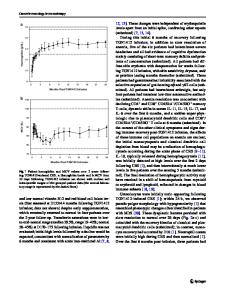COVID-19: more than a cytokine storm
- PDF / 794,099 Bytes
- 3 Pages / 595.276 x 790.866 pts Page_size
- 63 Downloads / 395 Views
COMMENTARY
Open Access
COVID-19: more than a cytokine storm Giovanni Riva1†, Vincenzo Nasillo2†, Enrico Tagliafico1, Tommaso Trenti1, Patrizia Comoli3 and Mario Luppi2* Background In these first months of coronavirus disease-19 (COVID19) pandemic, a mainstream pathogenetic hypothesis, likely stemming from early clinico-therapeutic observations, has been suggesting that severe COVID-19 may represent a sort of hyperimmune disorder, akin, in particular, to secondary hemophagocytic lymphohistiocytosis (sHLH) and macrophage activation syndrome (MAS) [1–3]. In this view, COVID-19-associated cytokine storm, with elevated plasma levels of IL-6, IL-1, and TNF-α, as well as ferritin and other inflammatory biomarkers, has been considered as a typical sign of sHLH/ MAS, but the other “key feature” of COVID-19—the progressive lymphopenia with T cell exhaustion [4–6]— has largely been neglected. Of note, both CD4+ and CD8+ T lymphocytes were found to be remarkably decreased in severe cases (median 177.5 and 89.0 × 106/L, respectively), when compared to moderate ones (median 381.5 and 254.0 × 106/L, respectively), thus suggesting T cell lymphopenia may constitute a potential prognostic marker to be included in the monitoring of COVID-19 patients [4]. Frequencies of IFN-γ-producing CD4+ T cells (i.e., cytotoxic Th1 subset) tended to be lower in severe than in moderate illness (median 14.1% versus 22.8%, respectively), possibly indicating a progressive skew of the Th1/Th2 balance toward a tolerogenic response [4]. In addition, the percentages of both memory Th cells and regulatory T cells were found to decrease in severe cases [5]. Nonetheless, in patients with severe systemic hyperinflammatory diseases driven by other viral infections, hemophagocytic syndrome can be expected as a rare but life-threatening event, and, indeed, sHLH has been recognized to occur in up to 4.3% of sepsis cases [1]. Hence, * Correspondence: [email protected] † Giovanni Riva and Vincenzo Nasillo contributed equally to this work. 2 Department of Medical and Surgical Sciences, University of Modena and Reggio Emilia; Hematology Unit, AOU Policlinico, Via Del Pozzo 71, 41124 Modena, Italy Full list of author information is available at the end of the article
in those COVID-19 patients showing massive hyperinflammation, a clinical diagnosis of sHLH/MAS may be appropriate and deserves further investigation at the histological level. More recently, COVID-19 clinical syndrome and related immunopathogenesis have been compared with sepsis, recalling the need to target the underlying and shared impairment of protective T cell immunity, while suppressing the emergent cytokine storm [7–9]. In fact, severe COVID-19 has appeared as a peculiar clinicopathologic entity—yet poorly understood from a mechanistic viewpoint—which however, by definition, may represent a novel form of viral sepsis, being characterized by (a) T cell deficiencies, with early and progressive lymphopenia; (b) systemic hyperinflammation, with a peculiar time-course, often increasing at a late
Data Loading...











